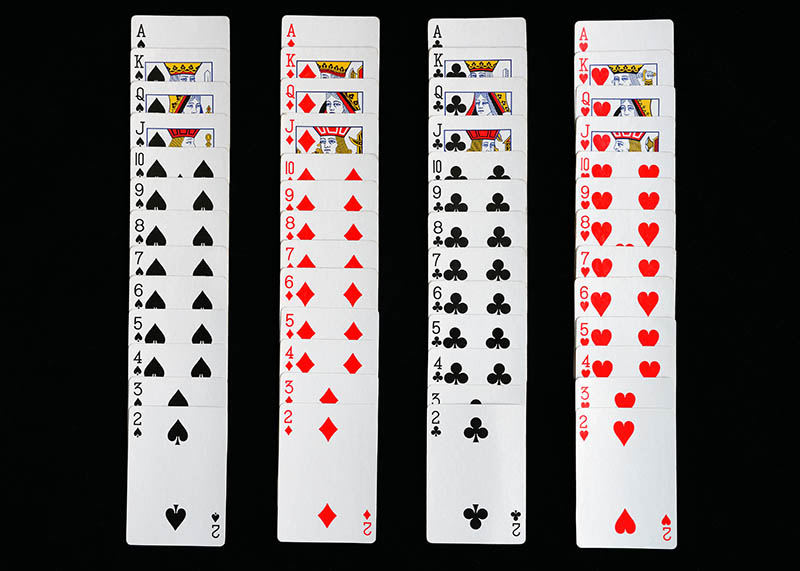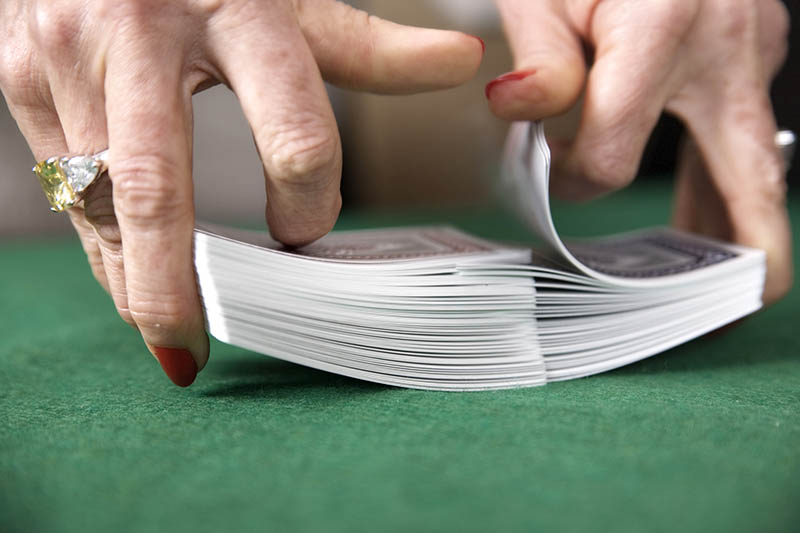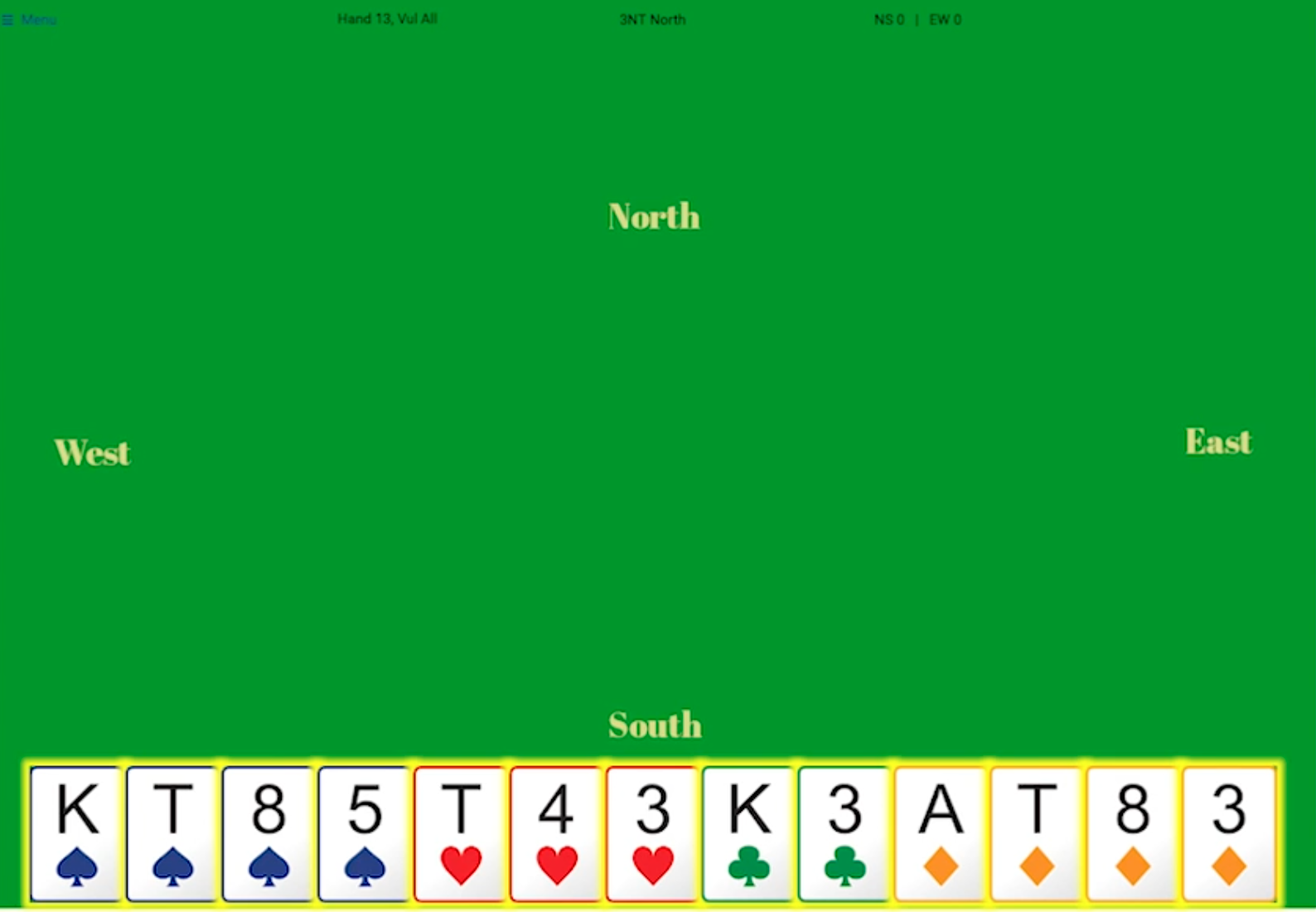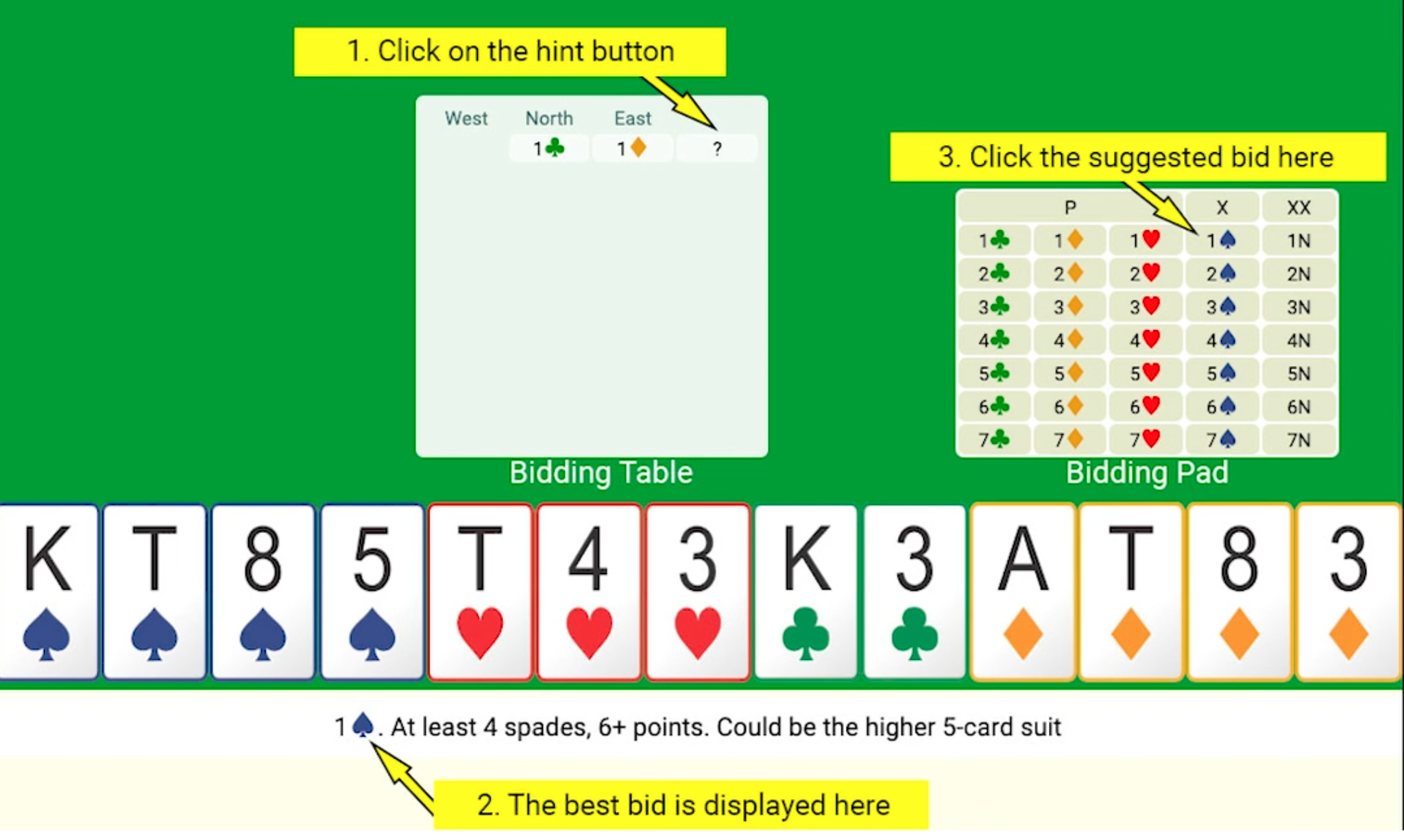How to play Bridge
Bridge is the ultimate of all the card games. Once you learn to play Bridge you will always find a game to play and friendly Bridge players to learn with. There are hundreds of Bridge clubs worldwide and according to Wikipedia more than 500,000 Bridge games are played online every day.
Follow our beginners lessons and you’ll be playing Contract Bridge in no time at all.
The game of Bridge uses a standard card deck of 52 cards with the jokers removed.
There are four players in each game, they form two partnerships.

North and South partnership sit opposite each other, as does the East and West partnership.

To start the game, the entire deck of cards is shuffled

and then dealt to the players
one at a time in a clockwise rotation,
each player receiving 13 cards.

A Bridge game is divided into two phases – biddingThis term is also called the 'auction.' In each online deal, a player is the nominated as the dealer -this title rotates each new game. The dealer is the player who starts the bidding even if its a pass. Players take their turn at bidding in turn and in order ... More and play.
Bridge is a trick taking game. A trick is four cards – created by each player placing a card into the center of the table.
In the bidding phase of the game the players each estimate how many rounds (tricksA round of 4 cards where each player contributes 1 card. There are 13 tricks in a game of bridge. More) they will win and what will be the dominant (trump) suit for that game. The bidding continues until three players in a row ‘pass’ (a no bid).
In the ‘play’ phase the players take turns to place a card into the center of the table. When there are 4 cards in the center it is called a ‘trick’. The highest card in the leading suit wins the trick and the trick count for that partnership is increased by one.
The game ends when all 13 cards have been played by each player. If the partnership that won the bidding
contractThe final suit and level of bidding sets the number of tricks and the trump suit for the game.This is called the contract. The partnership that wins the bidding can earn the points if they succeed in getting the number of tricks they contracted.
The number ... More, achieved the number of the trick they bid for then they have won.
Now, each phase in more detail…
Bidding

The bidding phase of a Bridge game is an auction where each player gets to estimate how many rounds they think they and their partner can win. If the winner of the auction then achieves their target they win the game and gain points and the opposition loses points. If the winner of the auction fails to achieve their target then they lose points and the opposition gains points.
The person who shuffled and dealt is called the Dealer, it is the responsibility of the Dealer to make the first bid whether it is a passed bid (P) or an opening bid.


The bidding involves knowing how high to bid with the hand you and your partner have altogether. Bidding is how you communicate the strength of your hand to your partner. Of course your opposition understand the strength of your hand from you and your partner’s bids as well, you are not allowed to have a private bidding system with your partner, you always need to have your partner able to describe what your bid means. The purpose of the bidding is to estimate how many rounds you and your partner could win together if they get the contract by making the highest bid followed by three passes (called winning the auction).
Bidding Example
- Your partner North starts the bidding with 1 Club (1C).
- East responds with 1 Diamond (1D).
- You (South) bid 1 Spade (1S)
- West says ‘Pass’ (No Bid)
- North bids one No TrumpA bid to play a hand without a trump suit where the highest card played to the suit first led to the trick - wins. This bid is peculiar to Bridge More (1NTThis bid in the opening position usually indicates that the bidder has a balanced distribution of suits however with some unbalanced hands you will respond 1NT just to keep the bidding low The distribution of suits in the hand can be in either of the three fol... More)
- East says ‘Pass’ (No Bid)
- You (South) bid 3 No trumps
- West, East and North then all ‘Pass’ so the bidding is over and the ‘Contract’ is 3 No TrumpsA suit of cards with the highest ranking over the other suits in a particular hand
Noun usage - A card in the trump suit whose trick-taking power is greater than any other suit card.
Verb usage - To play a trump after a plain suit has been led or otherwi... More*
The highest bid at the end of the bidding becomes the ‘Contract’. In this example North-South have the Contract and must win 9 ‘Tricks’ (rounds).
* ‘No Trumps’ means only a card of the same suit can beat a card eg. 9 of spades will beat an 8 of spades, but a 10 of hearts cannot.
NOTE: The minimum number of tricks you can bid for is 6, so winning the first tricks is assumed and so a bid of 1D or 1H or 1S means you need to win at least 7 tricks. eg. A bid of 2D or 2H or 2S means you must win at least 8 tricks.
Bidding Systems
Unlike similar games like Euchre and 500, the rules for bidding in Contract Bridge are very formal. There are a large number of ‘systems’ you can play but most players play a variation of one of two systems:
AcolThis is the bidding system that is more popular in the UK, Europe and Australasia. ACOL is according to The Official Encyclopedia of Bridge - "standard in British tournament play and widely used in other parts of the world". Largely a natural bidding system us... More: If you live in the UK, Ireland, Australia or New Zealand then you are much more likely to play using the Acol Bidding System
The Standard American Bidding System is played in most other countries. This system is also known by the names ‘SAYC’, ‘Stam’, ‘Five Card Majors’ and ‘American Contract Bridge’.
60SecondBridge supports both Acol and Standard AmericanA bidding system and it is an acronym for 'Standard American Yellow Card' which is the system most North American Players use. Also known as Five Card Majors or Goren by other players. More bidding. Our beginner lessons are relevant to both systems and then as you learn how to play bridge you must choose to use either the Acol or Standard American lessons (depending on the country you are in or sometimes what your friends play).
Essential Bridge Terms
Dummy
Once the first card (opening lead) has been played, the declarer’s partner exposes their hand for all
to see. For the remainder of the game the declarerThe player who during the auction made the first bid the SUIT of the final contract, becomes the declarer. The also play their partners hand which is now renamed 'dummy.'
Declarer plays both their own and dummy's hand. More will play their own hand and that of their
partner.
A little history: according to Britannica, the game of Bridge emerged out of Whist where, if there were only 3 players available to play a game, then the fourth hand could be played by one of the players as ‘dummy’.
Honor Cards
Essentially ‘honor’ cards are the ‘picture cards’ (Jack, Queen, King, Ace). These are awarded values by the player as a method of assessing the strength of their hand.
Ace (4)
King (3)
Queen (2)
Jack (1)
Trump Suits
The initial order of suits in each Bridge game is
- Spades (highest)
- Hearts
- Diamonds
- Clubs (lowest)
However that order can change as a result of the bidding. Part of the bidding process is for players
to nominate a ‘trump’ suit. This suit becomes the highest ranking suit for that game. eg. if a
player has a strong handOpeners strong hand contains 17+ points Responders strong hand contains 16+ points In NoTrump its high card points In a suit its total points (with distribution points) More in clubs they may bid for a ‘club’ contract. If they win the contract then
‘clubs’ becomes the trump suitThe suit of cards with the highest ranking over the other suits in a particular hand
Usage - A card in the trump suit whose trick-taking power is greater than any other suit card.
In bridge the trump suit is determined by highest bid that wins the contra... More for that game. The new order of suits for that game will be:
- Clubs
- Spades
- Hearts
- Diamonds
Play
After the bidding is finished the players enter the second phase of the Bridge game called ‘The Play’. This consists of 13 rounds where each player plays one card each in a clockwise order. Players must follow suit if they can. If you already play Euchre, 500 or Whist then the ‘Play’ phase will be very familiar (but there are no Jokers or Bowers in Bridge). Whoever wins the trick, is the next to play the first card on the next round.
A new of term needs to be defined here. The ‘declarer’ is first player to bid the suit of the final contract. eg. if north/south won the contract and the contract was 4 spades then whoever in the north/south partnership that first bid spades is designated as the declarer. The aim of the Declarer is to, at the bare minimum, win the number of rounds (tricks) they estimated in the bidding. The opposition are trying to stop the Declarer achieving this goal.
The first player to start the play is the player to the left of the the declarer. This first card played
is called the ‘opening lead’. The declarer then plays from the dummyThe declarer's partner is called the dummy, and after the opening lead has been made by the opposition dummy lays all their cards on the table face up.
That is the end of this game for dummy and they have no more to play in this game.
Declarer now plays ... More hand, the oppostion plays the third
card and the declarer plays the fourth card from their own hand. The winner of that round plays the
first card in the next round. The turns always proceed in a clockwise order.
The game ends when each player has played their 13 cards.
Scoring
Scoring is a more detailed subject which we will expand on in later lessons. When playing online at 60SecondBridge, the scoring is calculated automatically by the computer.
Summary
The above was an overview of how to play Bridge. The next lesson will outline how learning Bridge online at 60SecondBridge can greatly simplify the learning process for beginners. Then you’ll play your first game (with the assistance of the computer of course).
Commonly Asked Questions
Is Bridge difficult to learn?
Bidding and is the most complex part of Bridge but as you learn how to play Bridge online at 60SecondBridge you can use the bidding hints available until you are more familiar with the bidding rules. By using the online bidding tips you can be playing Bridge within an hour. As you learn to play Bridge you will increase your knowledge of the bidding rules until you are able to play without the online bidding hints. At this stage you will be able to play Bridge off the computer, but most Bridge players continue to play a combination of online and offline games each week.
Can You Play Bridge With 2 Players?
Online you only need one player, the computer can act as the other 3 players. Offline (with friends or at a club) 4 players are needed for each game. However often two players in a partnership will play four hands between them as practice as they discuss strategies and review past games and how scores could have been improved.
How Can Beginners Play Bridge?
Learning to play Bridge online has many advantages. There is no pressure to choose bids or card and you can use the in-built bidding hints to assist you with the complex bidding rules until you have built sufficient knowledge to play independently.
Instant Progress Quiz – Check the correct answer
Extra for Experts
A different game on the same subject as this lesson, with questions for community discussion in the comments area below.
PLAYResponses
You must be logged in to post a comment.

I was not able to understand the practice game from the lesson. I am uncertain what is meant by take out double and that convention based on what has been taught before in this lesson.
Don’t understand transfer bid?
https://members.60secondbridge.com/courses/conventions-in-bridge/lessons/512-jacoby-transfers/
The bidding discussion suggested I should be counting ‘winners.’ Where was the lesson for counting ‘winners?’
Here you go 🙂 https://members.60secondbridge.com/courses/300-declarer-dummy-card-play-lessons/lessons/301-in-no-trump-contracts-count-your-winners/
I signed up for SAYC no transfers. My first practice hand included Transfers. Help.
I changed your system to Standard American Weak Twos and No Transfers – You can change it back if you want under your profile.